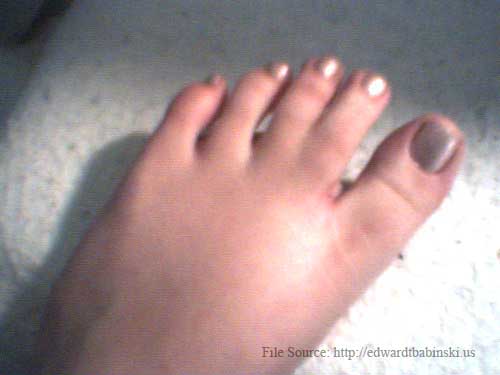

If the parents do decide to have their child undergo treatment, it is recommended that they wait until the child is at an age where they can properly care for their own feet after surgery. Some parents may choose to have the webbed toes treated. An x-ray is not usually necessary for this type of deformity. Only on rare occasions does it require treatment. Usually syndactyly is more of a cosmetic issue than a functional issue. If you are reading this and have webbed toes, you can thank you family for the nifty mutation the next time you see them. That mutation is what causes the webbed toe look on some people. Somewhere in your bloodline, someone carries a gene that has a mutation. Syndactyly is thought to be caused by genetics. In most instances, the webbed toes occur in the middle toes of the foot. Sometimes the toes are only partially webbed. There are various severities of syndactyly. It occurs in 1 out of every 2,000-2,500 live births. This condition is known medically as syndactyly. This makes the webbed toes look like those of a duck’s feet.
#Webbed feet humans skin#
This extra skin is connected to the sides of both toes and often fans out. Webbed toes are toes that have extra skin in between the crevices. That is because some people are born with webbed toes. Some human feet can look a little too similar to the feet of a duck. Not only do they help us balance and get moving, but our feet help us swim, stand, and participate in workouts. The human body is amazing, especially when it comes to its feet. Even human feet have some similarities to other feet of different mammals. Some are more closely structured to those of a human and others are completely and utterly different. or more likely simply put on a pair of flippers.Most living creatures on this planet have a set of feet, or something similar to feet. As for the specific prediction about webbed feet, it is true that humans could evolve webbed feet if appropriate genetic variation were available and they provided a selective advantage, but they could equally evolve a whole different set of solutions. "However detailed predictions of what kinds of adaptations will appear is notoriously tricky, and the comments made in the article appear as speculation rather than being based on any real theory. Human changes in response to climate change are no different. Evolutionary biologist Nick Colegrave, from the University of Edinburgh, told IBTimes UK: "It is true that whenever a species experiences changed selection pressures we expect natural selection to act and over time to change the characteristics of that species. While Skinner's predictions were just a bit of fun, the reality of how we will adapt to new climates is not so clear. If we were to colonise another planet, he predicts we would develop, longer arms, shorter legs and opposable big toes that would allow us to grip in weightless environments. In the ice age scenario, he said we would probably get hairier, more muscly and paler so we can absorb more vitamin D from less sunlight. #Extant Season 2 launches tonight at 9pm, and while we wonder if Molly can save mankind, leading paleoanthropologist, Dr Matthew Skinner, has predicted how our bodies could adapt to survive in three different future habitat scenariosPosted by SYFY on Wednesday, January 13, 2016 Due to the cold environment of being submerged in water regularly, we would maintain a layer of 'baby fat' into adulthood as an insulator." We may evolve a tapetum lucidum, an additional layer in the retina, like cat's eyes, that would improve our vision in low light conditions such as underwater.

Of the first, he said: "Regular underwater foraging would lead to the evolution of longer fingers and toes which would then likely develop 'webbed' interconnecting skin to enable easier swimming. He made predictions for three different scenarios – a water world where sea levels have risen, a second ice age as a result of an asteroid strike and if humans colonised other planets. Matthew Skinner, from the University of Kent, made the claims ahead of the launch of Syfy's Extant Season 2. Reports of how we will adapt to climate change emerged earlier this week. Humans are going to evolve to have webbed feet and hands, and maybe a set of gills as a result of sea level rising – or that is according to the predictions of a paleoanthropologist. Are we all going to be like Aquaman in a water world future? istock


 0 kommentar(er)
0 kommentar(er)
